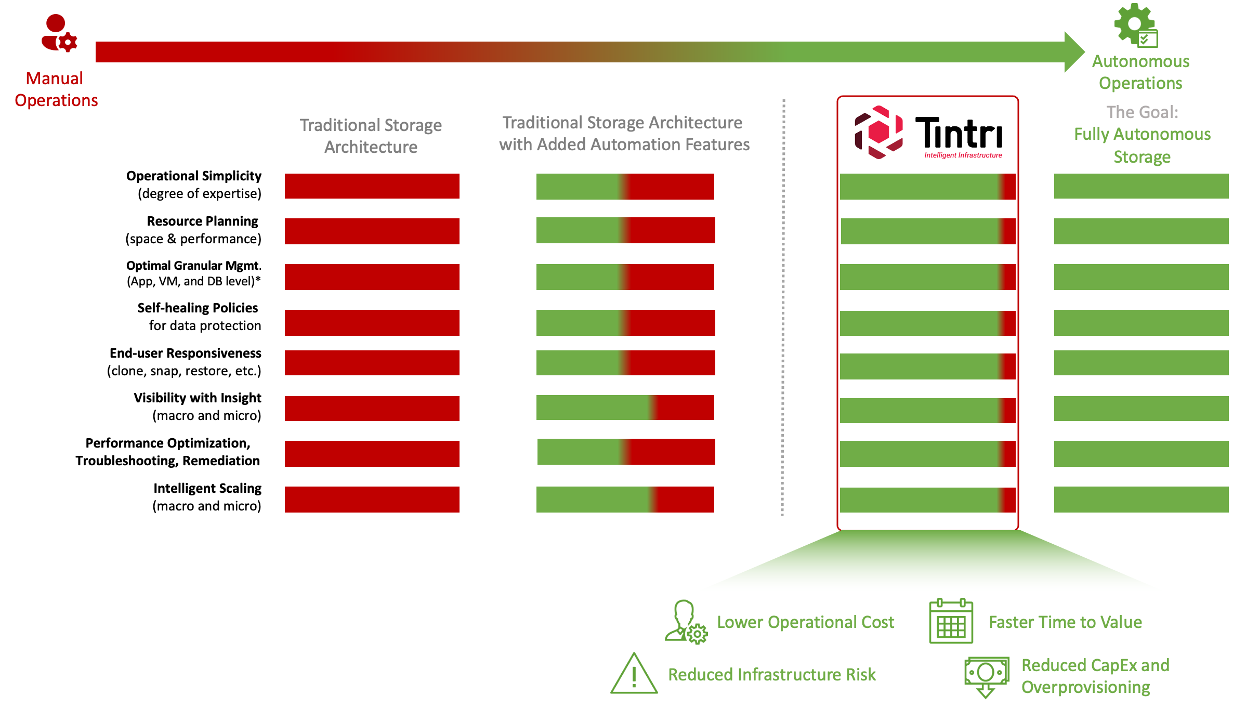
Brought to you by:
Enterprise Strategy Group | Getting to the Bigger Truth™
ESG ECONOMIC VALIDATION
The Economic Benefit of Autonomous Storage Operations with Tintri’s Intelligent Infrastructure
By Aviv Kaufmann, Senior Validation Analyst; and Stephen Catanzano, Consulting Analyst
OCTOBER 2021
ESG Technical Validations

Introduction
Challenges
Figure 1. Operational Efficiency Tops Most Important Objectives for Digital Transformation
What are your organization’s most important objectives for its digital transformation initiatives?
Source: Enterprise Strategy Group
The Solution: Tintri VMstore
Key features include:
Figure 2. Tintri VMstore's Intelligent Infrastructure

Source: Enterprise Strategy Group
Storage Automation versus Autonomous Storage
Figure 3. Tintri Is on the Path to Deliver Fully Autonomous Storage

Source: Enterprise Strategy Group
ESG Economic Validation
Tintri VMstore Economic Overview
Reduced Operational Expense Through Autonomous Administration
“Tintri gives us current and historical intelligence into performance of compute, network, and hypervisor layers that lets us not only predict our storage needs but the needs of our entire solution – I don’t know any other solution that can do that.”
“We just let the algorithms do their thing and there is never any need to second guess the intelligence – it just works and keeps things performing beautifully.”
Faster Time to Value to Enable Modern Businesses Agility and Maximize ROI
“We are no longer micromanaging the replication and snapshot process. We are now able to take the entire environment, instead of piecing it together and trying to fit it into proper maintenance windows, and run it 24x7 without impacting our end customers.”
Enhanced User Experience to Accelerate Efficiency, Productivity, and Innovation
ESG Analysis
Figure 4. Characterizing Manual Versus Autonomous Functionality across Storage Functions

Source: Enterprise Strategy Group
ESG’s 5-Year Modeled Scenario
Figure 5. Five-year Modeled Cost to Administer 1PB of Storage for VMs, Databases, and Applications

Source: Enterprise Strategy Group
Figure 6. Results of ESG’s Modeled 5-year TCO Analysis

Source: Enterprise Strategy Group
The Bigger Truth
This ESG Economic Validation was commissioned by Tintri and is distributed under license from ESG.
1 Source: ESG Research Report, 2021 Technology Spending Intentions Survey, Jan 2021. All ESG research references and charts in this technical validation have been taken from these master survey results.
All trademark names are property of their respective companies. Information contained in this publication has been obtained by sources The Enterprise Strategy Group (ESG) considers to be reliable but is not warranted by ESG. This publication may contain opinions of ESG, which are subject to change from time to time. This publication is copyrighted by The Enterprise Strategy Group, Inc. Any reproduction or redistribution of this publication, in whole or in part, whether in hard-copy format, electronically, or otherwise to persons not authorized to receive it, without the express consent of The Enterprise Strategy Group, Inc., is in violation of U.S. copyright law and will be subject to an action for civil damages and, if applicable, criminal prosecution. Should you have any questions, please contact ESG Client Relations at 508.482.0188.

Enterprise Strategy Group | Getting to the Bigger Truth™
Enterprise Strategy Group is an IT analyst, research, validation, and strategy firm that provides market intelligence and actionable insight to the global IT community.
